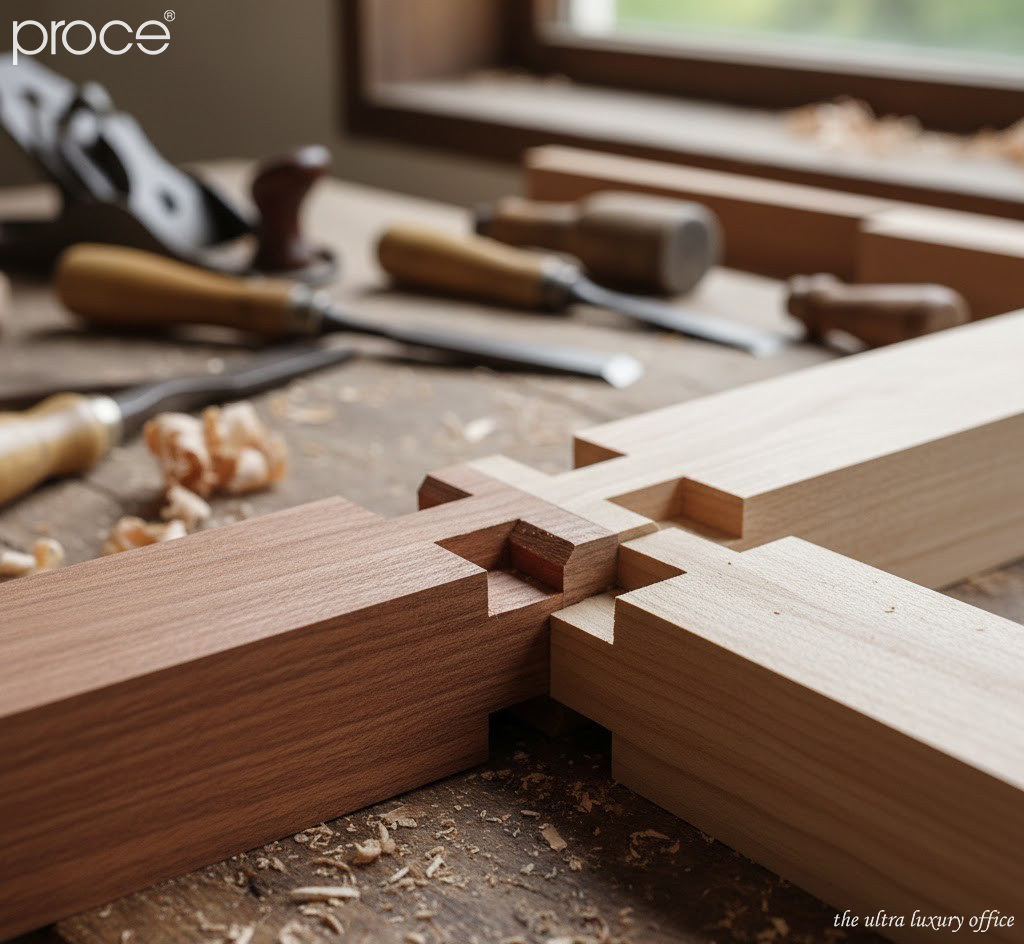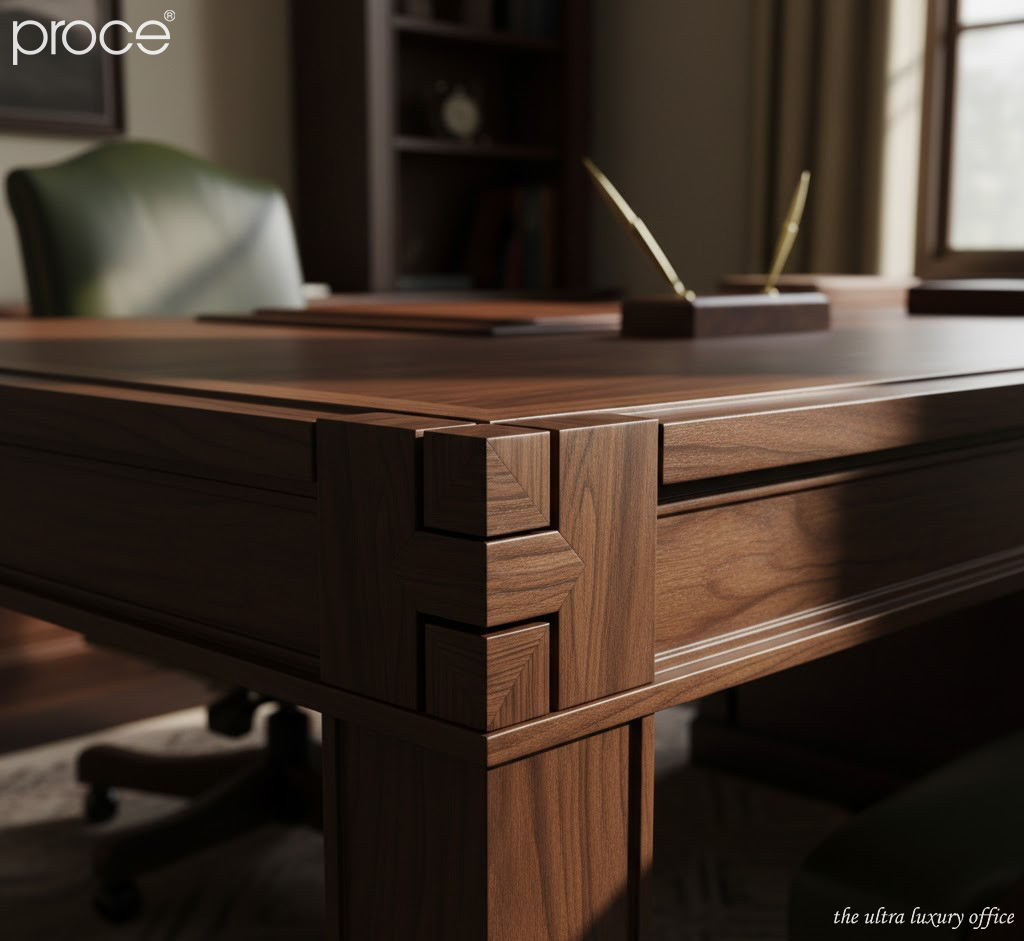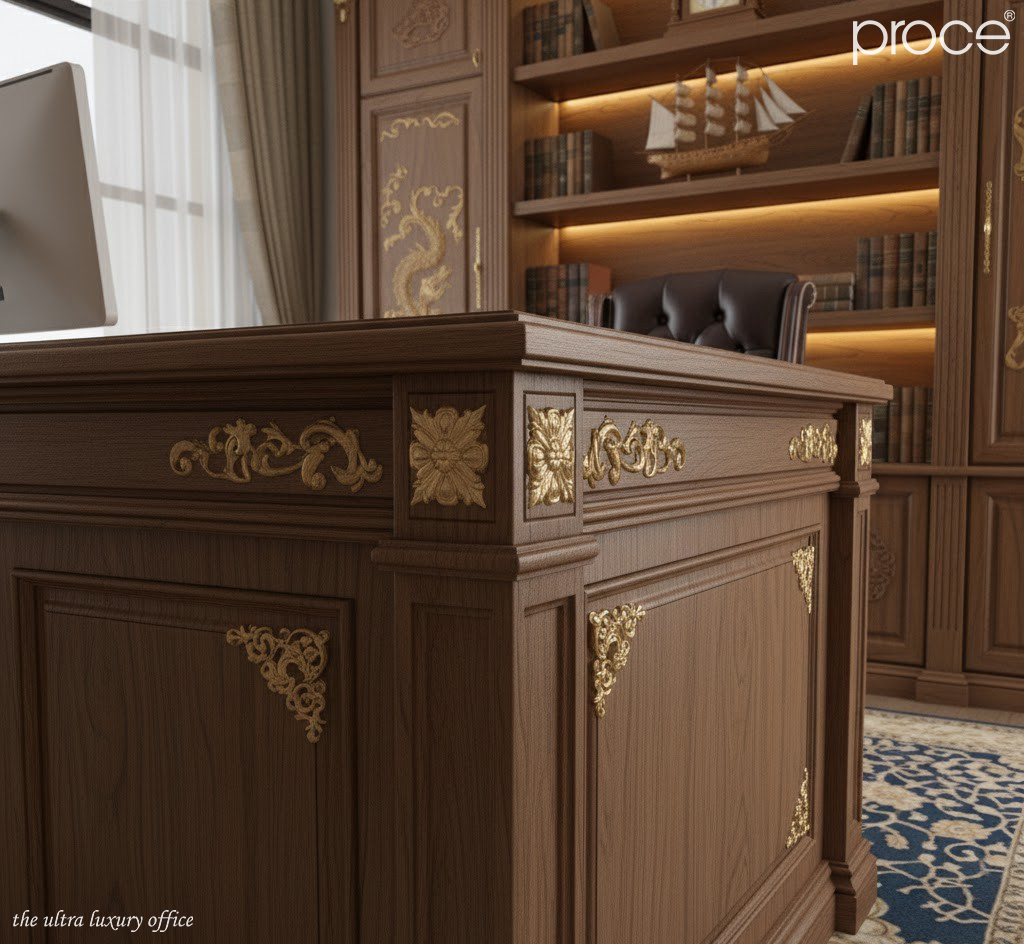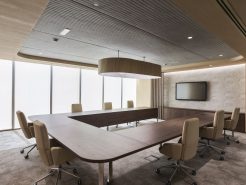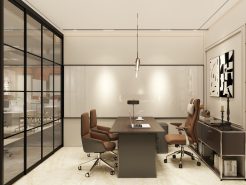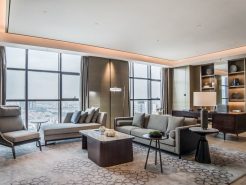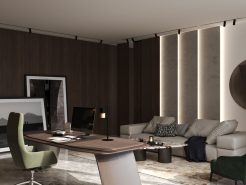No show, no exposure, no need for a screw to assert itself. Wood joints are the art of silence in design. Hidden deep inside is the absolutely precise fitting. Just like the way leaders always choose certainty over noise. As an interior designer, I always see wood joints appearing where power resides. Especially in the chairman office. Because for them, wood joints are not just a technique, but a philosophy: delicate, sustainable and no need to show off. In a place where every detail has its own language. Wood joints are a silent but valuable statement.
1. Why do wooden joints become an art in the design of the chairman office?
Wooden joints – The language of sophisticated connections in the interior of the chairman office
Wood mortise and tenon is a technique of joining wooden parts together without using screws, glue or any metal materials. This is a traditional art of mortise and tenon that has existed for hundreds of years in carpentry. It is considered the pinnacle of sophistication and precision. In terms of structure, this technique is based on the principle of “mortise and tenon”. A part of wood (mortise) is cut to a suitable shape to fit perfectly with the symmetrical part (mortise) of the remaining part. Depending on the structure, shape and purpose of use. Wood mortise and tenon can be transformed into square mortise and tenon, round mortise and tenon, herringbone mortise and tenon…
In the president’s working space – where neatness, class and longevity are emphasized. Wooden joints are applied as an artistic element. Combining manual techniques and design philosophy. Desks, filing cabinets or other interior details when processed with wooden joints. Will bring a seamless, solid, luxurious feeling. But still full of hidden meanings of the sophistication of power and timeless aesthetic taste.
Advantages of wood mortise and tenon over exposed screws
One of the reasons why wooden mortise and tenon joints are the preferred choice in the design of the president’s office is the ability to perfectly balance aesthetics. Durability, craftsmanship and flexibility in use. Unlike exposed joints with screws or glue that easily disrupt the sophistication of the overall design. The wooden mortise and tenon technique creates an almost invisible seamlessness. Each detail is carved in one piece, without a trace, without roughness. Bringing a discreet, yet sophisticated beauty. Exuding a gentle elegance, but full of inner strength.
In addition, the mortise and tenon structure helps distribute force evenly across the entire structural surface. Making the desk or filing cabinet always sturdy and not shaken even after decades of use. More importantly, each mortise and tenon joint is the result of a manual process that requires absolute precision and craftsmanship. Something that no industrial machine can replace. Each piece of furniture is not just a piece of furniture. It is a work of art, reflecting the personality and class of the owner.
And the special thing is that, despite being assembled sophisticatedly, the furniture using wooden joints can still be disassembled, maintained, and moved easily without breaking the structure. It is sustainable over time, along with flexible adaptability. Exactly the quality needed for a space for the leader. (Presidential room design – Why does the president’s room choose hidden hinges?).
2. Wooden joints – Small details, big position in the chairman office
Class comes from hidden details in the chairman office
One of the most obvious characteristics of a leader like the chairman is the restraint in expressing class. They do not need to show off through flashy details. Because what they own always contains outstanding sophistication. The wood mortise and tenon technique is the embodiment of that quiet luxury. Where perfection lies in the things that are not shown. The wood mortise and tenon is not present in the clicking sound of screws. It does not need light reflected from the metal. Instead, it is marked by the absolute harmony between the wooden details. So sophisticated that it is almost invisible.
In the design of the chairman’s desk, each wooden mortise and tenon joint is a hidden declaration. That the owner not only has power, but also has aesthetic depth. They are sophisticated enough to realize that luxury lies not in what is easy to see. But in what others cannot imitate. And it is the “hidden” wooden mortise and tenon that brings the furniture to another level. Where every detail, though not revealed, still contributes to shaping the leadership’s temperament.
Show position through quality
In the world of leaders, value is not in form. It is in depth and originality. A president’s desk is more than just a piece of furniture. It is a symbol of vision and leadership. Therefore, common techniques such as screwing, although convenient and popular, still feel mass-produced, industrial, and lacking in personality. On the contrary, wood joints are products of human hands, of manual measurement. Of each joint created as a part of the body. It is unique and people in high positions always look for unique things, instead of mass.
The difference here is also in the feeling. A table made of wooden joints always brings a feeling of solidity, seamlessness and perfection. Not only in structure, but also in temperament. When entering that workspace, people will immediately recognize that this is the place of a person who does not accept compromise with mediocrity. No need to show off, but still exudes a powerful luxury. Because in this class, class does not need to be shown off with logos or flashy materials. But lies in the way every detail is completed silently but absolutely. No need for explanation, but still convincing enough. (Top 5 reasons why the president’s office hinges have to bear heavy loads).
Feng Shui and Space Energy – When “Wood” Brings a Soft Sense of Authority
Asians have long valued feng shui in living and working spaces. Especially in high-level leadership positions. In that world, the energy of materials plays an important role in balancing the spirit and promoting work efficiency. Metal is often present in screw joints or hinges. It is considered a “cold” and hard material. Sometimes it makes the space dry and heavy. On the contrary, wooden joints are the subtle embodiment of the “wood” element. Warm, soft but sturdy. It brings a natural balance to the space. Creates a feeling of relaxation, comfort and helps users maintain a stable, focused mental state.
The key to creating an energetic workspace
In the president’s office – where important decisions and strategic meetings take place. A feeling of comfort, concentration and mental stability is indispensable. A table crafted with the mortise and tenon technique is not only a structural solution. It is also the key to creating a seamless space in terms of energy. No metal clanking, no interruptions by rough details. Everything is present in a calm, natural and profound way.
When the hand touches the natural wood surface, skillfully joined by mortise and tenon. That feeling is not cold, not interrupted, but warm as if in contact with a living object. That is a way of “subtle grounding”. It helps keep the leader in a state of alertness, clarity but still dignified and relaxed. At this time, feng shui is no longer a distant, mysterious concept. It has become a factor that is intentionally calculated in the language of high-end interior design. Where every material, every joint contributes to nurturing a true leadership temperament.
Workspace is a personal brand statement
For leaders, especially at the president level. The workspace is like a sophisticated stage for personal branding. Here, they receive guests, sign contracts, make strategic decisions and send implicit messages about their leadership style. A table using wood mortise and tenon technique, although not ostentatious or highlighted by flashy details. However, it still quietly conveys a clear message: the person sitting behind it is a perfectionist, sophisticated. And especially values the value of every detail, even the smallest.
In the interior of the president’s office, materials and construction techniques are not only functional factors. They are also an aesthetic language that expresses personal thinking and class. Choosing wooden joints instead of conventional assembly methods such as screwing or gluing is not simply a technical decision. It is a declaration of a lifestyle. Not accepting ease, not following the majority. But pursuing precision and sophistication down to each joint.
The owner’s “invisible logo”
Just like luxury brands do not need a large logo to assert their class. A desk using wooden mortise and tenon joints does not need to be ostentatious, but still exudes a distinct identity. That is the “invisible logo” of the owner, only those who are sophisticated enough can recognize it. Therefore, the chairman’s desk cannot be a hastily assembled or mass-produced product. It must be a handcrafted work, where each mortise and tenon joint is crafted with near-absolute precision. Not just to connect parts. But to convey a leadership style. Steadfast, perfectionist and with a clear aesthetic taste. (Design and construction budget for the president’s office according to function).
Conclude
In the design of the president’s office, there are details that say nothing, but force others to listen. The wooden joints are one of them. No exposed screws, no rough marks. Only precise joints down to the millimeter. Like a tacit agreement between materials and craftsmanship. Through many years of working in chairman offices. I understand: wooden joints are not only to maintain the structure. But also to maintain a standard of living. Because for the leaders, the neatness in each joint is not for show. But to remind the thinking that also needs to be designed tightly like that.
PROCE – TOTAL LUXURY OFFICE SOLUTION
Website: https://proce.vn/
Youtube: https://www.youtube.com/@noithatvanphonghangsang
Fanpage: https://www.facebook.com/vanphongnhapkhauProce
GG Business: https://business.google.com/dashboard/l/15115233216900975876
Linkedin: https://www.linkedin.com/company/74359718/admin/
Hotline: 090.115.6767
#phong_lam_viec_chu_tich; #phong_chu_tịch; #thiet_ke_phong_lam_viec_chu_tich
#noi_that_phong_lam_viec_chu_tich; #thiet_ke_noi_that_phong_lam_viec_chu_tich
#phong_lam_viec_chu_tich_chuan_sang; #phong_lam_viec_chu_tich_dang_cap


